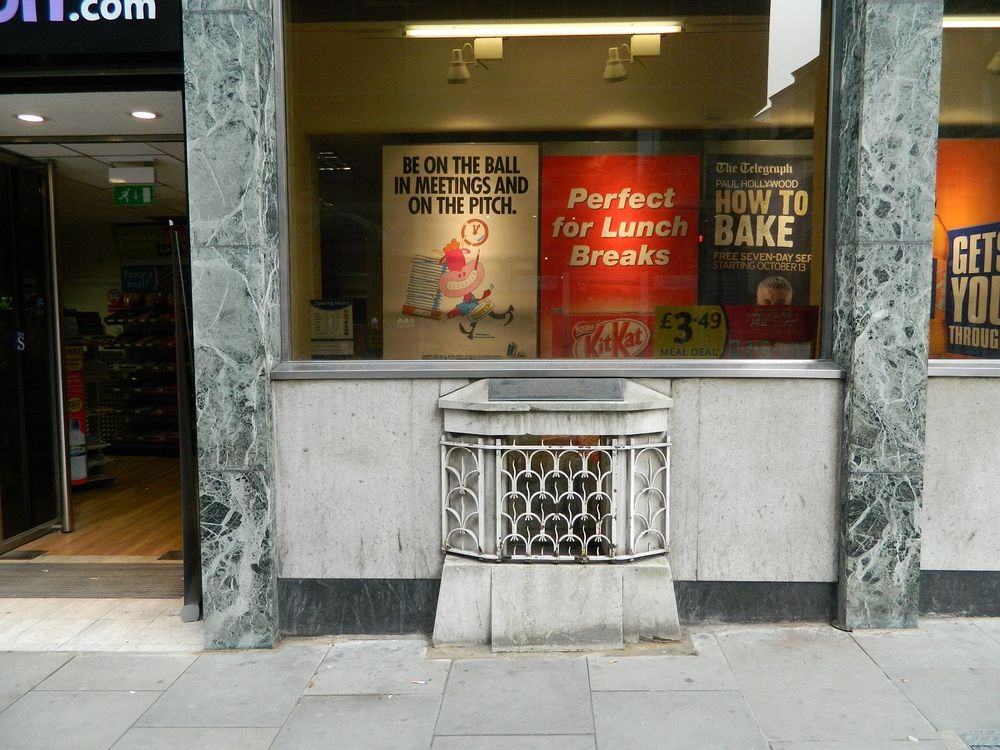Embedded inwards the wall of 111 Cannon Street , inwards the City of London , exactly to a higher house the sidewalk , is a minor grilled window that appears similar a decorative skylight for an hole-and-corner basement. Behind it , inwards a drinking glass enclosure too dimly lit from within , is an irregular chunk of oolitic limestone , believed to last i of London’s nearly ancient too of import relic. But nobody remembers what it was used for.
Ignored past times the thousands of Londoners who walk past times the grilled window every 24-hour interval , the London Stone has stood inwards or some the same topographic point on present-day Cannon Street for at to the lowest degree a grand years , too mayhap fifty-fifty two. The stone’s mysterious beginning has fascinated people for centuries too fifty-fifty appeared inwards the industrial plant of Shakespeare , William Blake too Dickens.

Photo credit: www.thehistoryblog.com
The mention "London Stone" kickoff appeared inwards written tape some the twelvemonth 1100 , too was a well-known landmark inwards medieval London. In 1450 , when Jack Cade , the leader of a peasant uprising , entered the metropolis , he struck his sword on London Stone too declared himself the "Lord of this city" , an incident immortalized past times Shakespeare inwards "Henry VI , Part II ,". By the fourth dimension of Queen Elizabeth I London Stone was non exactly a landmark , but a visitor attraction inwards its ain right. Tourists flocking inwards to come across the rock mightiness accept been told diverse stories regarding its beginning , that it was laid upwards past times the club of King Lud , legendary rebuilder of London , equally the oculus of the metropolis or that it served equally a house for tendering too making of payment past times debtors.
As the centuries rolled past times , the legends too stories became to a greater extent than elaborate. By the early on 19th century , many writers began to believe that the rock was business office of an altar or foundation dating from the fourth dimension of Brutus of Troy , the legendary but in all likelihood fictional descendant of the Trojan hero Aeneas , known inwards medieval British legend equally the founder too kickoff manlike individual monarch of Britain. Others suggested that it was used past times the Druids equally a house of worship.
The nearly pop explanation of the rock , that it was laid upwards past times the Romans too used equally a fundamental rock from which all distances inwards Roman U.K. were measured , came from the 16th century London historian William Camden , fifty-fifty though in that place is no archaeological show to back upwards it.
Photo credit: Andrea Vail/Flickr
It’s believed that the London Stone was originally larger , too was damaged too reduced inwards size sometime inwards the 17th century , mayhap inwards the Great Fire of London inwards 1666. The remaining business office of the rock was later covered amongst a minor rock cupola to protect it. But when the rock started to hinder traffic crusade , it was moved , twice , in i trial inwards 1742 too in i trial to a greater extent than inwards 1798. The minute fourth dimension it was relocated , it was laid inwards a rock example inwards the southern wall of St Swithin’s Church , where it remained for over 150 years , throughout the whole 19th Century.
In 1962 , St Swithin’s Church was demolished too the London Stone was laid inwards its electrical current place inwards a edifice contrary Cannon Street Station. Ten years later , the London Stone too its grilled box became a Grade II listed structure.
The bronze plaque on overstep of the casing , installed inwards 1962 , reads:
LONDON STONE
This is a fragment of the master copy slice of limestone in i trial securely fixed inwards the the world forthwith fronting Cannon Street Station.
Removed inwards 1742 to the northward side of the street , inwards 1798 it was built into the S wall of the Church of St. Swithun London Stone which stood hither until demolished inwards 1962.
Its beginning too role are unknown but inwards 1188 in that place was a reference to Henry , boy of Eylwin de Lundenstane , later Lord Mayor of London.
Jack Cade on London Stone. Photo credit: www.thehistoryblog.com
Church of St Swithin , London Stone , inwards Cannon Street , London , amongst the casing of London Stone prominent inwards the middle of the front end wall; engraving after Thomas H. Shepherd , 1831. Photo credit: T. H. Shepherd/Wikimedia
The stone's sometime casing. Photo credit: Walter Thornbury/British Library/Wikimedia
The edifice where the London Stone is located , behind the grilled window , is occupied at diverse times past times diverse businesses. This icon is from a fourth dimension when in that place was a sporting goods store. Photo credit: www.thehistoryblog.com
Photo credit: MANHATTAN RESEARCH INC/Flickr
Photo credit: John O'London/Wikimedia
Photo credit: tpholland/Flickr
Sources: Wikipedia / Mysterious Britain / LA Times







